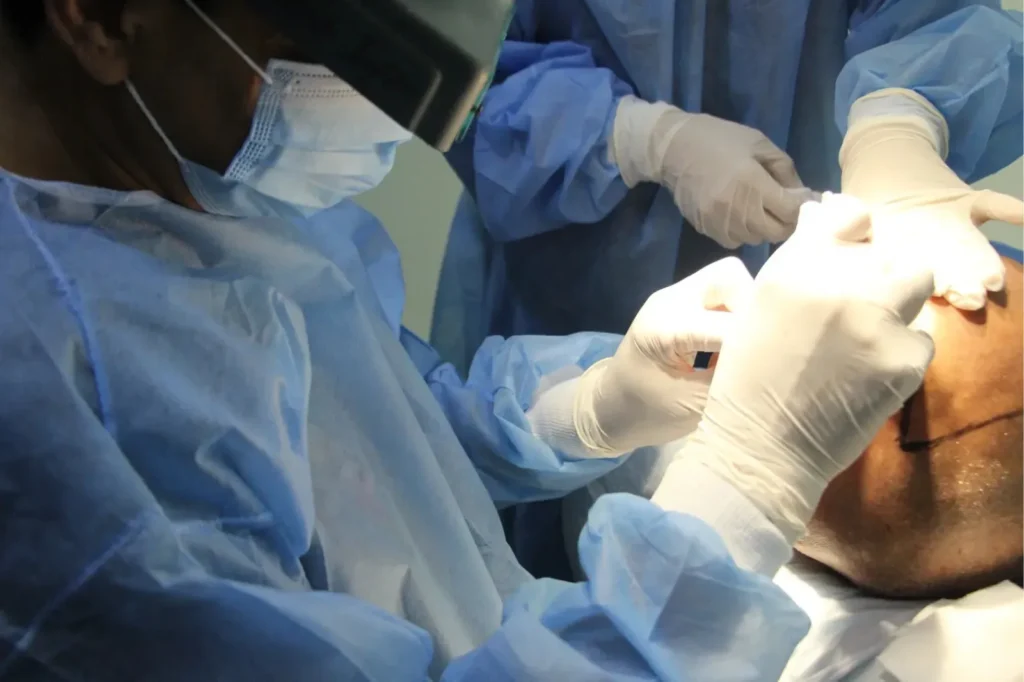Struggling with limited scalp donor hair for your hair transplant? You’re not alone. Using beard hair for hair transplant is becoming an increasingly popular option, especially for patients with low scalp donor supply or corrective transplant needs.
In this comprehensive guide, you’ll learn how it works, whether it’s safe, and how experts like Dr. Rana Irfan use it for successful, natural-looking results. Read on for expert insights, benefits, and real patient examples.
What Is Beard Hair Transplantation?

Definition & Technique
Beard hair transplantation involves extracting hair follicles from the beard—typically under the chin or jawline—and implanting them into balding areas of the scalp. This method is often done using FUE (Follicular Unit Extraction), where individual grafts are harvested with precision.
How It Differs from Scalp Hair Transplant
Unlike scalp donor hair, beard hair is thicker, coarser, and grows in a different cycle. While scalp hair is ideal for frontal hairlines, beard hair is typically used to add volume in the crown, mid-scalp, or to repair poor transplant results.
Common Medical Terms
- BHT (Body Hair Transplant): The general term for using hair from body areas like the beard or chest.
- FUE with beard grafts: Technique involving the extraction of beard hair using FUE tools.
Why Use Beard Hair for Hair Transplant?
Ideal for Patients with Low Scalp Donor Supply
Not every patient has sufficient donor hair on the scalp. Beard grafts can offer an excellent alternative, especially in cases of advanced baldness (Norwood 5+).
Beard Hair Characteristics
Beard hair typically has:
- Greater shaft diameter
- Faster anagen (growth) phase
- A tendency to stay robust after transplantation
These traits make it useful for adding density, particularly in thicker regions like the crown or for corrective work.
Applications
- Crown area thickening
- Scar repair from FUT procedures
- Second-time transplants where the scalp supply is exhausted
Suitability & Candidacy Criteria
Who Can Benefit?
Beard hair transplantation is best for:
- Men with thick, dense beard growth
- Patients with depleted scalp donor areas
- Individuals seeking repair of failed or unnatural transplants
Skin & Hair Type Considerations
- Works best on individuals with thick facial hair and similar skin tone on the face and scalp
- May not be suitable for fair-skinned or light-bearded individuals
Beard-to-Scalp Compatibility
Factors that influence success:
- Curl or wave pattern
- Color match
- Graft survival rate in the new location
Pro Tip: Always consult a certified surgeon to assess beard-to-scalp compatibility before committing.
Beard Hair Transplant Procedure: Step-by-Step
Pre-Surgery Evaluation
- The density and quality of the beard donor area are assessed
- Matching with the recipient area is planned
Extraction from the Beard (FUE Method)
- Local anesthesia applied
- Micro punches (0.7mm–1.0mm) extract individual follicles
Graft Preparation & Implantation
- Grafts are sorted based on size and direction
- Implanted into balding areas with careful angulation for natural results
Recovery Timeline
- Redness and swelling subside in 3–5 days
- The beard area heals within 7–10 days
- Visible growth from new grafts starts in 3–4 months
- Final results are typically seen in 9–12 months
Benefits of Using Beard Hair for Hair Restoration
- High graft yield: 1,500–3,000 grafts can be harvested in ideal cases
- Minimal scarring: Especially when performed with FUE by an experienced surgeon
- Thicker appearance in the crown and mid-scalp
- Corrective potential: Great for camouflaging pluggy or unnatural hairlines
Risks and Limitations
- Texture mismatch: Beard hair is thicker and may not blend in with the hairline
- Lower graft survival if not done properly
- Beard scarring or patchiness, though rare, with skilled hands
- Longer procedure time and higher surgeon skill required

Recovery & Aftercare
Healing in the Beard Donor Area
- Tiny scabs form and fall off in a week
- Shaving can resume after 10–14 days
- No permanent changes in beard growth when extracted correctly
Post-Transplant Care Guidelines
- Keep both donor and recipient areas clean
- Avoid direct sunlight and shaving the beard for 10 days
- Use prescribed antibiotics or topical creams
Hair Growth Timeline
- Shock loss may occur in the first 2–3 weeks
- Initial regrowth in 3–4 months
- Mature results by months 9–12
Beard vs Scalp Hair Transplant: What’s Better?
| Feature | Beard Hair | Scalp Hair |
|---|---|---|
| Texture | Coarse | Fine to medium |
| Best For | Density in crown/repair | Frontal hairline |
| Availability | High in some patients | Limited in advanced baldness |
| Growth Cycle | Faster | Natural matching |
Expert Tip: Combine both scalp and beard grafts for the best natural results.
Cost of Beard Hair Transplant in Pakistan
Average Price Range
- PKR 80–120 per graft
- Total cost: PKR 150,000–350,000, depending on the number of grafts and the clinic location
Factors Influencing Cost
- Number of grafts
- Surgeon’s expertise
- Clinic location (Islamabad, Lahore, Karachi)
- Use of advanced tools or a combination with scalp grafts
FAQs About Using Beard Hair for Hair Transplant
Can beard hair really grow like scalp hair?
Yes, though the texture may differ, beard grafts grow permanently on the scalp.
How many grafts can be taken from the beard?
Up to 3,000 in ideal candidates.
Will my beard look patchy afterward?
Not if the extraction is done strategically by a skilled surgeon.
Is the result permanent?
Yes, transplanted beard hair grows like normal scalp hair.
Can beard hair be used in FUT?
No, beard grafts are only suitable for the FUE technique.
Is beard hair transplant painful?
Mild discomfort, but mostly painless with local anesthesia.
Take Your Next Step
Looking for a solution to limited donor hair? Dr. Rana Irfan, an ABHRS and ISHRS-certified surgeon in Islamabad, offers personalized evaluations and advanced techniques like FUE with beard grafts for optimal results.
👉 Book your consultation today to explore your options and take the next step toward confident, natural hair restoration.
